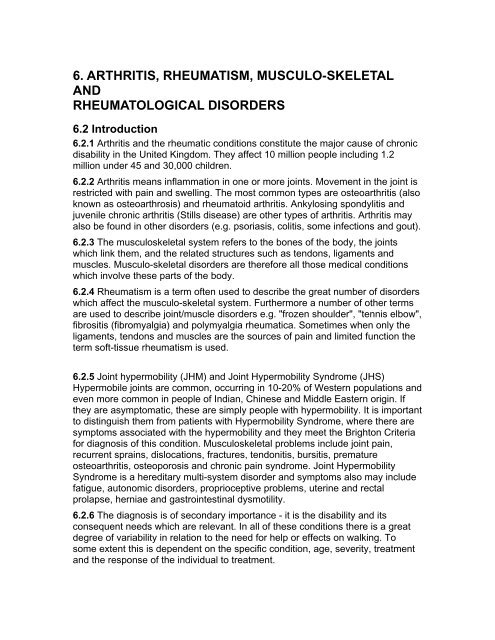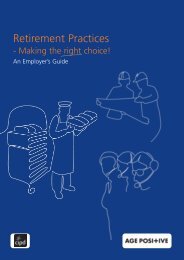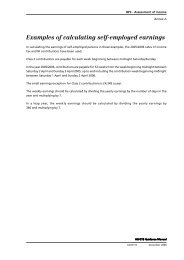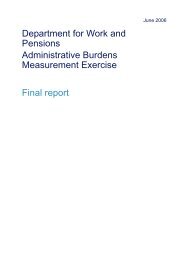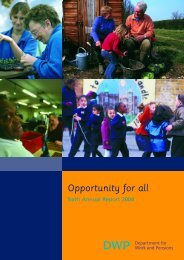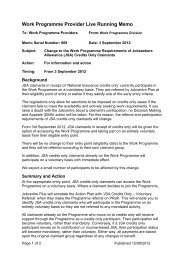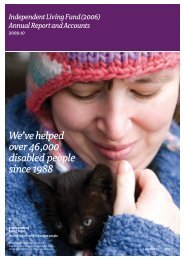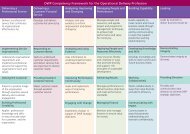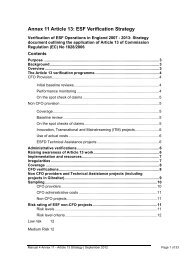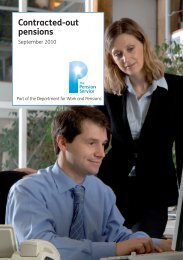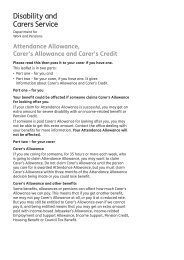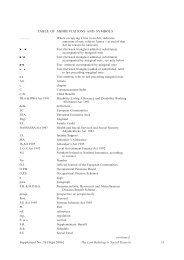Arthritis, rheumatism, musculo-skeletal and rheumatological disorders
Arthritis, rheumatism, musculo-skeletal and rheumatological disorders
Arthritis, rheumatism, musculo-skeletal and rheumatological disorders
Create successful ePaper yourself
Turn your PDF publications into a flip-book with our unique Google optimized e-Paper software.
6. ARTHRITIS, RHEUMATISM, MUSCULO-SKELETAL<br />
AND<br />
RHEUMATOLOGICAL DISORDERS<br />
6.2 Introduction<br />
6.2.1 <strong>Arthritis</strong> <strong>and</strong> the rheumatic conditions constitute the major cause of chronic<br />
disability in the United Kingdom. They affect 10 million people including 1.2<br />
million under 45 <strong>and</strong> 30,000 children.<br />
6.2.2 <strong>Arthritis</strong> means inflammation in one or more joints. Movement in the joint is<br />
restricted with pain <strong>and</strong> swelling. The most common types are osteoarthritis (also<br />
known as osteoarthrosis) <strong>and</strong> rheumatoid arthritis. Ankylosing spondylitis <strong>and</strong><br />
juvenile chronic arthritis (Stills disease) are other types of arthritis. <strong>Arthritis</strong> may<br />
also be found in other <strong>disorders</strong> (e.g. psoriasis, colitis, some infections <strong>and</strong> gout).<br />
6.2.3 The <strong>musculo</strong><strong>skeletal</strong> system refers to the bones of the body, the joints<br />
which link them, <strong>and</strong> the related structures such as tendons, ligaments <strong>and</strong><br />
muscles. Musculo-<strong>skeletal</strong> <strong>disorders</strong> are therefore all those medical conditions<br />
which involve these parts of the body.<br />
6.2.4 Rheumatism is a term often used to describe the great number of <strong>disorders</strong><br />
which affect the <strong>musculo</strong>-<strong>skeletal</strong> system. Furthermore a number of other terms<br />
are used to describe joint/muscle <strong>disorders</strong> e.g. "frozen shoulder", "tennis elbow",<br />
fibrositis (fibromyalgia) <strong>and</strong> polymyalgia rheumatica. Sometimes when only the<br />
ligaments, tendons <strong>and</strong> muscles are the sources of pain <strong>and</strong> limited function the<br />
term soft-tissue <strong>rheumatism</strong> is used.<br />
6.2.5 Joint hypermobility (JHM) <strong>and</strong> Joint Hypermobility Syndrome (JHS)<br />
Hypermobile joints are common, occurring in 10-20% of Western populations <strong>and</strong><br />
even more common in people of Indian, Chinese <strong>and</strong> Middle Eastern origin. If<br />
they are asymptomatic, these are simply people with hypermobility. It is important<br />
to distinguish them from patients with Hypermobility Syndrome, where there are<br />
symptoms associated with the hypermobility <strong>and</strong> they meet the Brighton Criteria<br />
for diagnosis of this condition. Musculo<strong>skeletal</strong> problems include joint pain,<br />
recurrent sprains, dislocations, fractures, tendonitis, bursitis, premature<br />
osteoarthritis, osteoporosis <strong>and</strong> chronic pain syndrome. Joint Hypermobility<br />
Syndrome is a hereditary multi-system disorder <strong>and</strong> symptoms also may include<br />
fatigue, autonomic <strong>disorders</strong>, proprioceptive problems, uterine <strong>and</strong> rectal<br />
prolapse, herniae <strong>and</strong> gastrointestinal dysmotility.<br />
6.2.6 The diagnosis is of secondary importance - it is the disability <strong>and</strong> its<br />
consequent needs which are relevant. In all of these conditions there is a great<br />
degree of variability in relation to the need for help or effects on walking. To<br />
some extent this is dependent on the specific condition, age, severity, treatment<br />
<strong>and</strong> the response of the individual to treatment.
6.2.7 It is highly unlikely that the joints of people past middle age will be as<br />
supple, strong <strong>and</strong> resilient as those of the younger person. X rays of the joints of<br />
people past middle age (<strong>and</strong> sometimes in even younger people) may show<br />
abnormalities of the lining cartilage <strong>and</strong> the bones that make up the joints (e.g.<br />
thinning of the cartilage, "wear <strong>and</strong> tear", bony outgrowths, etc), but these<br />
radiological (i.e. X ray) findings may be present in very many people who do not<br />
have any problems in those joints. An X-ray report of joints which describes<br />
"arthritic changes" does not necessarily mean that the person with such changes<br />
has any significant pain or problem with that joint.<br />
6.3 Osteoarthritis (Osteo-Arthrosis, Degenerative Joint Disease)<br />
6.3.1 This disease of joints is not usually inflammatory but is characterized by<br />
wear <strong>and</strong> tear of the joints <strong>and</strong> is generally age related. It is the commonest type<br />
of arthritis. Joints which are particularly prone to develop osteoarthritis are the<br />
hip, knee, h<strong>and</strong>s <strong>and</strong> spine. Past or continuing trauma (ie injury) to the joints can<br />
accelerate the onset of osteoarthritis<br />
6.3.2 In the great majority of persons with osteoarthritis the disease is mild (with<br />
minimal or no needs) <strong>and</strong> principally affects one particular joint, which is the main<br />
source of pain <strong>and</strong> discomfort, such as the knee or hip, with minor or no<br />
involvement of other joints. The condition may have come to light during x-ray<br />
examination, even before the symptoms were noticed. See para 6.2.7 above. In<br />
other people, however, the disease is more severe, causing deformity <strong>and</strong><br />
extreme pain in affected joints. The problems may be alleviated by surgery, to<br />
replace the diseased joint with an artificial one (prosthesis). Those most<br />
commonly replaced in this way are the hip <strong>and</strong> knee joints. This operation is most<br />
often successful in significantly relieving joint pain <strong>and</strong> restoring pain-free<br />
movement.<br />
6.3.3 In older people multiple joints are affected <strong>and</strong>, because of disuse of the<br />
joints due to pain, there may be muscle wasting. This can be a factor contributing<br />
to falls in the elderly See Chapter 4.<br />
6.3.4 Care Needs<br />
(i) In osteoarthritis, the need for help, <strong>and</strong> its frequency, will depend very much<br />
on the number <strong>and</strong> location of joints involved <strong>and</strong> the degree of deformity,<br />
which may be so severe that surgical intervention is necessary to correct it<br />
<strong>and</strong> to relieve pain.<br />
(ii) Loss or limitation of h<strong>and</strong> <strong>and</strong> arm function may lead to a need for help<br />
during the day. In the early stages of the condition manual dexterity may be<br />
impaired leading to difficulty in h<strong>and</strong>ling common utensils. It may also make<br />
simple household tasks difficult or dangerous depending upon the degree of<br />
loss of function <strong>and</strong> reduced manual dexterity, <strong>and</strong>, of course, whether one or<br />
both h<strong>and</strong>s/arms are involved.<br />
(iii) When hip <strong>and</strong>/or knee function is limited or restricted with reduction in the<br />
ranges of movement at these joints, there may be problems with bathing,
dressing <strong>and</strong> undressing the lower half of the body, going up <strong>and</strong> down stairs<br />
<strong>and</strong> rising from a chair <strong>and</strong> in walking. In the older person, help may be<br />
needed getting out of bed in the morning <strong>and</strong> back in at night.<br />
(iv) Even when suitable, readily available, equipment or technical aids resolve<br />
some difficulties, others may persist <strong>and</strong> will depend upon individual<br />
circumstances.<br />
6.3.5 Mobility Considerations<br />
(i) Loss of hip <strong>and</strong>/or knee functions, especially when these are associated<br />
with problems in the ankles <strong>and</strong> feet, may lead to substantial difficulties in<br />
walking <strong>and</strong> being able to get around both in the home <strong>and</strong> outdoors. When<br />
the knee is affected the joint may become unstable, increasing the risk of falls,<br />
particularly in elderly people.<br />
(ii) In people with long-st<strong>and</strong>ing <strong>and</strong> advanced osteoarthritis of weight-bearing<br />
joints (such as the hip, knee, ankles <strong>and</strong> feet, etc) treatment with pain-relieving<br />
drugs (analgesics) or anti-inflammatory medications <strong>and</strong> physiotherapy, etc,<br />
may not significantly improve walking. Where joints have been replaced,<br />
however, walking itself <strong>and</strong> pain associated with walking is usually very much<br />
improved.<br />
6.3.6 Duration of Needs<br />
In people with the much more common milder forms of osteoarthritis care needs<br />
are minimal <strong>and</strong> walking is not usually limited to a significant extent. However,<br />
even in people with the milder forms of osteoarthritis affecting the weight-bearing<br />
joints there may be short periods lasting several weeks when there is increased<br />
pain <strong>and</strong> stiffness which may affect care needs <strong>and</strong> walking. The duration of<br />
established care needs <strong>and</strong> walking difficulties may be reduced, or even<br />
eliminated, by successful replacement with prosthetic joints.<br />
6.4 Inflammatory Joint Diseases<br />
6.4.1 Rheumatoid arthritis is a chronic inflammatory disease involving many<br />
joints simultaneously (polyarthritis), <strong>and</strong> most commonly involving the small joints<br />
of the h<strong>and</strong>s <strong>and</strong> feet, in a symmetrical fashion (i.e.: both wrists, both ankles).<br />
The affected joints become painful, swollen, stiff <strong>and</strong> in some cases deformed.<br />
The effects of disability are generally more severe than in osteoarthritis. Its onset<br />
is most often in a younger age group than those affected by osteoarthritis - even<br />
in childhood - but it may start in the older person. Many complications (in adults<br />
<strong>and</strong> children) may be found in severe arthritis which involve various parts of the<br />
body, including the heart, small blood vessels, the lungs, kidneys, eyes <strong>and</strong><br />
spleen.<br />
6.4.2 In juvenile chronic arthritis (Still's disease), the disease tends to affect the<br />
larger joints <strong>and</strong> growth can be impaired. Prognosis (outcome) is more<br />
favourable than in rheumatoid arthritis. For the majority of children the disease<br />
will "burn out" by the age of 16 or 18. Response to surgery such as hip or knee<br />
replacement is usually successful.
6.4.3 Other diseases which manifest principally as a chronic polyarthritis are<br />
psoriatic arthritis, reactive arthritis (Reiter's Syndrome), <strong>and</strong> ankylosing<br />
spondylitis.<br />
6.4.4 Psoriatic arthritis is similar to rheumatoid arthritis, the main difference being<br />
that it is usually associated with the skin condition psoriasis, <strong>and</strong> usually leads to<br />
less overall joint disablement. Rarely it can give rise to a particularly severe form<br />
of arthritis with severe joint destruction <strong>and</strong> resulting gross disablement when<br />
care needs will be at least as great as those described for severe rheumatoid<br />
arthritis.<br />
6.4.5 Reactive arthritis is a polyarthritis found in association with certain<br />
infections in other parts of the body. These are often in the gut or the urogenital<br />
system.<br />
6.4.6 Ankylosing spondylitis mainly involves the joints of the spine, is commoner<br />
in men, <strong>and</strong> often leads to a stiff <strong>and</strong> rigid spine. Symptoms may become worse<br />
with time, spreading from the low back to mid back <strong>and</strong> then the neck. Unless<br />
other joints than the spine are involved care needs <strong>and</strong> mobility considerations<br />
will be similar to those in people with the painful back See Chapter 7.<br />
6.4.7 Care Needs<br />
(i) In rheumatoid arthritis there is characteristically a prolonged period of joint<br />
stiffness in the morning on arising from bed, <strong>and</strong> after sitting in a chair for<br />
some time. During these periods of joint stiffness the affected person has to<br />
"limber-up" slowly <strong>and</strong> so may need help with dressing, rising from bed/chair,<br />
<strong>and</strong> washing. Bathing or showering in the morning may assist in the<br />
"limbering-up" process, <strong>and</strong> help would be required for this. The duration of<br />
morning stiffness often exceeds an hour in those with active inflammation of<br />
several joints. Even in remission, between the flare-ups, damaged joints may<br />
be painful <strong>and</strong> stiff in the mornings causing difficulties in taking medication,<br />
bathing <strong>and</strong> dressing.<br />
(ii) Damage to the joint structure may result in weakness of ligaments, tendons<br />
<strong>and</strong> surrounding muscles, causing the h<strong>and</strong>s <strong>and</strong> wrists to be weak with<br />
markedly impaired grip <strong>and</strong> loss of dexterity. Involvement of the finger joints<br />
may also seriously impair grip <strong>and</strong> manual dexterity, preventing the person<br />
from h<strong>and</strong>ling utensils, <strong>and</strong> making it difficult to cut food. In the early stages<br />
there may only be slight impairment of manual dexterity but help may be<br />
needed in the preparation of meals. If the shoulders <strong>and</strong> neck are affected<br />
this, too, may lead to difficulties with washing, dressing, cutting up food, <strong>and</strong><br />
eating. Putting on <strong>and</strong> taking off outdoor clothing, splints (when used) <strong>and</strong><br />
collars may also pose problems.<br />
(iii) Except in those with highly active disease, there should be little need for<br />
attention at night for such activities as toileting <strong>and</strong> turning in bed. During flareups,<br />
however, when splints <strong>and</strong> collars are used at night, removal of these to<br />
attend to toilet needs may be difficult. Help may also be required, in these<br />
circumstances, for taking pain relief medication.
(iv) Due to disuse atrophy (i.e. wasting of muscles) because of painful lower<br />
limb joints, falls can be a problem, generally in the older person.<br />
(v) In ankylosing spondylitis, because of back stiffness, assistance may be<br />
needed with lower garments when dressing <strong>and</strong> in getting in <strong>and</strong> out of the<br />
bath.<br />
6.4.8 Mobility Considerations<br />
(i) Walking may well be impaired in those with active inflammation of joints in<br />
lower limbs. When the feet are affected, this may cause severe pain on<br />
walking. If knees <strong>and</strong> hips are involved, st<strong>and</strong>ing <strong>and</strong> sitting can be difficult<br />
<strong>and</strong> painful, <strong>and</strong> walking more severely limited.<br />
6.4.9 Duration of Needs<br />
(i) The needs of persons with highly active joint inflammation may lessen<br />
dramatically when spontaneous remissions occur or in response to drugs.<br />
These drug treatments are associated with an improvement in the extent <strong>and</strong><br />
severity of arthritis. When this occurs it will be likely to do so within about one<br />
year's treatment. Patients are most responsive to treatment in the initial stages<br />
of rheumatoid arthritis (i.e. 2 to 5 years following onset).<br />
(ii) There will be older patients with a longst<strong>and</strong>ing history of rheumatoid<br />
arthritis in whom the disease may be "burnt-out", leaving many of the smaller<br />
joints of the h<strong>and</strong>s deformed with poor h<strong>and</strong> function or resulting in fixed<br />
deformities of lower limb joints with impairment of walking ability. In these<br />
people the needs will depend upon the overall disablement in the individual<br />
case but are unlikely to change throughout the remainder of the person's life.<br />
(iii) In the majority of people with rheumatoid arthritis, the disease smoulders<br />
on, involving further joints, <strong>and</strong> slowly increasing levels of disability <strong>and</strong><br />
associated needs.<br />
6.5 Osteoporosis<br />
6.5.1 Osteoporosis is the name given to a reduction or thinning in the total mass<br />
of bone present in the body. The precise mechanism causing this disease is<br />
unclear. It is found most frequently in women after the menopause, particularly in<br />
the older woman; <strong>and</strong> in people receiving long-term treatment with steroid<br />
compounds, e.g., for rheumatoid arthritis. Sometimes the condition is noted in<br />
younger women who have had their ovaries removed (oophorectomy).<br />
Inadequate physical activity promotes generalised osteoporosis <strong>and</strong> the condition<br />
also occurs in various gl<strong>and</strong>ular <strong>disorders</strong> <strong>and</strong> in cases of severe malnutrition<br />
<strong>and</strong> chronic renal (kidney) disease.<br />
6.5.2 The condition is of variable severity. In its mild form it may give rise to no<br />
symptoms <strong>and</strong> may be a chance X-ray finding. When the condition is more<br />
severe, pain may be a feature. This is usually due to fractures of the "brittle"<br />
bones, often occurring after only minor injury. Persistent backache may occur<br />
later on in the disease, due to progressive compression or collapse of several
vertebrae. The healing of fractures is not usually impaired <strong>and</strong>, with healing, the<br />
pain usually subsides. There is also a tendency for the condition to improve<br />
spontaneously, or with treatment. Suitable physical exercise is also helpful.<br />
6.5.3 Care Needs <strong>and</strong> Mobility Considerations<br />
(i) In all but its most severe forms osteoporosis of itself may be symptomless<br />
<strong>and</strong> give rise to no mobility problems or care needs. Even when there has<br />
been very considerable loss of bone mass it will be the pain <strong>and</strong> functional<br />
limitations associated with fractures or bone collapse (particularly in the back)<br />
that may give rise to care needs <strong>and</strong> mobility problems. In these severe cases<br />
(generally in elderly women) there may well be considerable care needs<br />
arising from disability associated with fractures. These commonly occur in the<br />
region of the wrist, back <strong>and</strong> hip joint. When fractures occur in the back or in<br />
the weight-bearing joints there may well be adverse effects on walking.<br />
Progressive collapse of the spinal vertebrae may result in a shortened, curved<br />
back causing chronic pain <strong>and</strong> walking problems.<br />
(ii) A person affected with this level of disease <strong>and</strong> its complications may also<br />
have difficulty with getting in <strong>and</strong> out of bed, rising from a chair, dressing <strong>and</strong><br />
undressing, preparing a main meal <strong>and</strong> attending to toilet needs. Under such<br />
circumstances, <strong>and</strong> particularly in elderly people, there may be care needs<br />
both by day <strong>and</strong> by night.<br />
(iii) When assessing the care needs which may arise, consideration should<br />
also be given to any other recorded disability(ies) which may give rise to<br />
mobility problems or care needs in their own right <strong>and</strong> which may interact with<br />
any needs arising from osteoporosis.<br />
(iv) Although the intellect is not affected in this disease, any tendency to fall<br />
may give rise to supervisory needs in elderly frail people, because of the<br />
increased risk of broken bones, <strong>and</strong> difficulty in rising after a fall..<br />
6.5.4 Duration of Needs<br />
Fractures heal at the normal rate, so that any resultant disability may not last<br />
more than a few weeks or months. This is particularly so in the younger person.<br />
In elderly people with osteoporosis who have sustained frequent fractures with<br />
progressive collapse of the spinal vertebrae, significant improvement in disability<br />
<strong>and</strong> care needs is unlikely during the remainder of the person's life.<br />
6.6 Joint Hypermobility Syndrome<br />
6.6.1 The Joint Hypermobility Syndrome (JHS) is a multi-system inherited<br />
connective tissue disorder thought to be caused by faulty fibrous tissue matrix<br />
proteins such as collagen. It is indistinguishable from Ehlers-Danlos Syndrome –<br />
Hypermobility type (previously known as Ehlers-Danlos type III).
6.6.2 Tissue laxity results in increased flexibility, an asset to some dancers,<br />
gymnasts, musicians <strong>and</strong> athletes. However, fragile tissues are prone to overuse<br />
injury, rupture <strong>and</strong> healing is poor <strong>and</strong> often delayed.<br />
Muscle <strong>and</strong> joint complications - joint pain, sprains, tendonitis, bursitis,<br />
recurrent dislocations, fractures, early arthritis <strong>and</strong> osteoporosis, chronic spinal<br />
disc problems with back <strong>and</strong> neck pain, chronic pain syndrome.<br />
Other complications - stretchy poor healing skin, uterine <strong>and</strong> rectal prolapse<br />
<strong>and</strong> stress incontinence, proprioceptive impairment leading to clumsiness <strong>and</strong><br />
falls, fatigue. Gastro-intestinal problems (abdominal pain, constipation,<br />
gastroparesis, reflux – can require multiple medications <strong>and</strong> even naso-gastric<br />
tube or PEG feeding). Autonomic Disorders occur in 78% of patients <strong>and</strong> include<br />
Vasodepressor Syncope <strong>and</strong> Postural Orthostatic Tachycardia Syndrome (PoTS)<br />
(increased pulse rate on st<strong>and</strong>ing or prolonged sitting can result in reduced blood<br />
supply to the brain <strong>and</strong> compensatory high adrenaline levels. Symptoms include<br />
fainting, dizziness, fatigue, poor concentration <strong>and</strong> memory problems,<br />
headaches, palpitations, tremor, sense of anxiety, nausea, sweats <strong>and</strong> visual<br />
problems. It produces functional impairment similar to that found in COPD <strong>and</strong><br />
heart failure).<br />
6.6.3 Joint Hypermobility Syndrome is under-diagnosed. In one survey, over 50%<br />
of patients waited over 10 years from onset of symptoms to receive a diagnosis.<br />
Many doctors (including some rheumatologists) are sceptical about its serious<br />
impact on patient’s lives.<br />
It can be difficult to match disability with patient appearance as they often look<br />
<strong>and</strong> move well .Assessors may incorrectly assume that because a joint has good<br />
range of movement <strong>and</strong> is not swollen, it cannot be painful.<br />
6.6.4 People with JHS often respond poorly to analgesics <strong>and</strong> local anaesthetics.<br />
With frequent <strong>and</strong> persistent painful episodes <strong>and</strong> poor pain control, they often<br />
develop widespread chronic pain with pain amplification <strong>and</strong> kinesiophobia<br />
(avoidance of movement to avoid pain). Deconditioning develops.<br />
Depression is common due to chronic uncontrolled pain, difficulty with tasks of<br />
daily living, diagnostic delay <strong>and</strong> failure to recognise symptom severity.<br />
6.6.5 Care Needs<br />
(i) People with severe forms of the Joint Hypermobility Syndrome may be in<br />
frequent or constant pain that is worsened by movements, especially those<br />
involving physical effort such as lifting. Joints may dislocate following minimal<br />
movement. When the tissues are damaged, physically dem<strong>and</strong>ing activities<br />
are also painful <strong>and</strong> give rise to care needs from another person. Periods of<br />
rest throughout the day may be required after only a modest amount of<br />
physical activity. Falls may occur so that certain activities such as bathing,
using stairs, etc may need to be supervised, particularly in elderly people with<br />
this syndrome.<br />
(ii) Main meal preparation, especially cutting up vegetables, opening jars,<br />
lifting pans <strong>and</strong> using taps may prove to be difficult .At times assistance may<br />
be required with toileting <strong>and</strong> personal hygiene.<br />
(iii) Special consideration may be required in the workplace. Chairs may need<br />
to be adapted to suit individual’s need e.g. high back, lumbar support, elevated<br />
seat. It may be necessary to adapt taps <strong>and</strong> door-h<strong>and</strong>les. Repetitive use of<br />
susceptible joints should be avoided. Special transport considerations may be<br />
necessary. Advice from an occupational therapist, physiotherapist or<br />
occupational health department may be helpful. Employees with autonomic<br />
complications may require a cool environment with the ability to take short<br />
regular breaks to eat <strong>and</strong> drink. Prolonged st<strong>and</strong>ing <strong>and</strong> sitting should be<br />
avoided. They may have special dietary requirements. Profound fatigue is a<br />
common problem <strong>and</strong> can impair stamina <strong>and</strong> concentration.<br />
6.6.6 Mobility Considerations<br />
(i) Because the connective tissues are lax <strong>and</strong> fragile they may be easily<br />
injured or dislocate. The combination of unstable, painful joints <strong>and</strong> balance<br />
problems may make walking difficult. People with severe forms of the<br />
syndrome require the use of walking aids (cane, crutches) or wheelchair.<br />
Patients can become bed-bound.<br />
6.6.7 Duration of Needs<br />
(i) Pain can result from sudden injuries to the soft tissues which take weeks or<br />
months to heal. Overenthusiastic physiotherapy from practitioners inexperienced<br />
with Joint Hypermobility Syndrome may exacerbate symptoms. Long delays in<br />
diagnosis means that many patients (for example 24 % of patient attending their<br />
first appointment at UCH Hypermobility Clinic) have established chronic pain<br />
syndrome <strong>and</strong> requiring a multi-disciplinary team approach to management.<br />
6.7 Further Evidence<br />
Because of the wide range of clinical manifestations <strong>and</strong> spectrum of disability<br />
<strong>and</strong> needs it may often be necessary to obtain further evidence, in the form of a<br />
GP or physiotherapist report or a report by an examining medical practitioner. A<br />
rheumatologist’s report may be particularly helpful.


